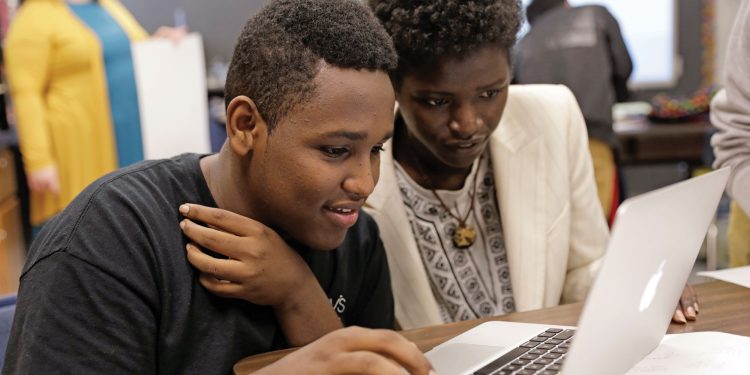This fifth, newest and smallest high school in Bowling Green opened in August 2016 on Warren Central High School’s campus after much planning and little fanfare. A bustling hub and self-contained learning center, the 10-room school is comprised of eight classrooms with a single administrative office and a multi-purpose common room for its 188 students.
The Geo International High School is on the cutting edge of providing top quality academic public education to a burgeoning refugee and immigrant population.
GIHS students are from refugee and immigrant families from about 20 countries throughout Central and South America, Europe, Asia and Africa, speaking 20 to 25 vastly diverse languages and dialects, including Spanish, Arabic, Somali and variations of Burmese, a Sino-Tibetan language group.
Students may opt into the GIHS program if they meet two qualifications: having less than four years of U.S. residency and proficiency test scores in the bottom 25 percent of standardized English language tests. The average age of GIHS students in 2016 was 19 years old, with the age range being 16 to 21.
The Beginning
With more than 27 years of classroom and administrative experience, director of English learner programs Skip Cleavinger has been the driving force behind the school’s establishment.
Concerned with the high dropout rate of older ELLs in the district, he recognized that English language proficiency is the most fundamental requirement before effective academic instruction can occur and has championed profound changes in the English learner program.
In 2014, Warren Central High School principal Mike Stevenson and Cleavinger went to New York for consultation on the school design and development at the Internationals Network of Public Schools. GIHS is the sole Kentucky affiliate of the Internationals Network Schools.

How It’s Structured
Established in 2011, the Gateway to Educational Opportunities Center functions as the central clearinghouse for processing all refugee and immigrant students’ school enrollments. The GEO Center serves as an outreach and resource center, provides enrollment packets and student assessments and administers English proficiency tests to determine each student’s grade level. The center also offers teachers professional development in ESL issues.
Core subjects taught at GIHS are English, math, science and social studies. Teachers are required to have a bachelor’s degree, Kentucky certification and an ESL endorsement.
The staff includes associate principal Adam Hatcher, a guidance counselor and one administrative assistant and is comprised of two cohorts: Team A, freshman and sophomores, and Team B, juniors and seniors. The teams are broken into carefully selected groups to contain the most and least proficient English speakers.
“These students are architects of the school,” Cleavinger said.
Students cooperate on projects with flexibility to communicate in English and their own languages to grapple with ideas and problems unlike a traditional full immersion, English only approach. They acquire knowledge as they build vocabulary and develop creative thinking skills.
Students are typically driven, goal oriented and motivated to prepare for higher education and frequently take dual college credit courses offered through Warren Central. In a single year, GIHS has already revolutionized and transformed traditional teaching methods from content teaching to project-based, practical application, academically focused schooling with remarkable success. The WCHS graduation rate in 2017 was just 71 percent for English learners. In the same year, the 22 members of the first senior class at GIHS had a 100 percent graduation rate, and 18 of those ELL students are now attending college.
GIHS students use the district school libraries, Western Kentucky University libraries and have access to a gymnasium. Transportation and meals adhering to students’ religiously dictated dietary laws are provided in the adjacent school cafeteria, and the school has a quiet area for daily prayers.
Funds come from public sources of the school district, the state, grants and Title 3 federal funding.
Why Bowling Green?
The Bowling Green International Center and Catholic Charities of Louisville Migration and Refugee Services are two of the resettlement agencies that have contributed to the rapid population increase in Warren County. About 3,000 refugees and thousands of immigrants — both legal and undocumented native speakers of over 60 languages and dialects from 35 to 40 countries — have settled here since 2011.
“Kentucky is the third largest state in the country in growth of immigration,” Cleavinger said. “We are the No. 1 diverse district in the state.”
About one in five students is classified as an English Language Learner. Recent increases in the number of students from Syria, Iraq, Congo and Myanmar are the result of continuing wars and unrest in their native countries.

The School’s Importance
Foreign language learning becomes increasingly difficult with age, and English is an inherently challenging language to master. There are many obstacles to graduation to overcome including culture shock, embarrassment and the desire or obligation for older students to help provide financial support. Refugees and immigrants from war torn countries may have little formal schooling and may be illiterate in their native tongue. Some have witnessed deaths, horrific injuries or experienced torture and suffer emotional and psychological trauma. Others have been malnourished or endured famine. They have been displaced from their homelands, separated from families and generally impoverished.
Warren County Public Schools is at the forefront in reaching out to the growing refugee and immigrant populace in Bowling Green to ensure students receive the same opportunities as citizens for obtaining quality education.
Hatcher suggested several students whose survival stories exemplify the extreme hardships endured and sacrifices made as their displaced families have fled from grave danger to relocate with hope for a better future. While refugees are rapidly changing the demographics of Bowling Green, these students’ energetic determination to learn English, excel academically and build a successful future promises betterment of the entire community. In spring 2016, the students recalled personal heritage stories, which were bound and published. Some of their memories are shared here.
Meet the Students
Faisal Hassan is an 18-year-old senior who has lived with his mother and sister in Bowling Green for three and half years. He arrived with limited English skills and now is a proficient speaker. Hassan speaks four languages and can read Arabic. His interests include soccer, playing table pool and robotics. He takes robotics classes at Warren County Area Technology Center and is a member of the first GIHS soccer team. He was born in Kenya to Somali parents who later returned to Somalia where his father died, a civilian casualty of ongoing civil warfare.
“My father, Yusuf, was a great man devoted to helping others,” Hassan said. “He believed helping people was a reward in the world and the hereafter.”
His mother was the youngest child in an educated family that included doctors and scientists.
Somalia has endured decades of political unrest, continuous fighting among warlords and rebel factions, famine, enduring severe drought and shortages of clean water. The cost in human lives and the death knell of a culture is immeasurable as millions have died and millions have been displaced. The situation is so dire that International Humanitarian Aid efforts have ceased. The United Nations withdrew workers in 2001 and stopped food shipments in 2005 as they were being seized by rebel forces.
Zan Ma Win is a 17-year-old senior who arrived in Louisville eight years ago with her mom, dad and four siblings. She was born in Burma and named by a Buddhist monk to receive his good fortune and blessings. Her family first relocated to Thailand to escape local violence, war and unemployment. They moved to the U.S. in search of freedom and education. When they resettled in Bowling Green, she spoke no English but quickly acquired English language proficiency. Her home language is Burmese, but her mother speaks Karen, and her family speaks Thai. Burmese has neither past nor future tenses nor does it distinguish single or plural cases and lacks the verb “to be.” The length of residency qualifier for GIHS was waived to allow Ma Win to enroll in last year’s inaugural class. She has completed five college courses while enrolled in high school. She enjoys nail art, drawing, learning and plays on the school’s recreational tennis team. Her family keeps their cultural heritage alive through their music and by attending a Burmese temple in Bowling Green.
“Most students that come from a Burmese background still call the country Burma, although some use the official name Myanmar,” Hatcher said. “Others refer to their ethnic origins or say they come from Thailand. Almost all of the GIHS Burmese students were born in a refugee camp and never actually lived in Burma.”
He likens their coming to America as “landing on an alien planet since the language, food, culture, dress and general way of life is totally foreign.”


















